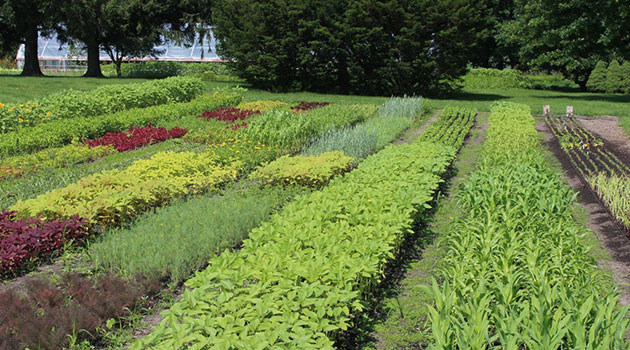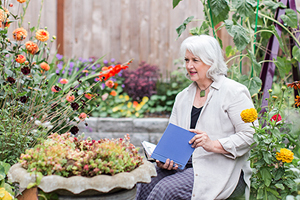- 3 Easy, Reliable, Productive Cut Flowers: Sunflowers, Zinnias & Rudbeckia
- 5 Factors That Determine Vase Life of Cut Flowers
- American Flowers Week: Combining the Art of Floral Design & Couture
- Celebrating the 8th American Flowers Week | Johnny's 2022 Botanical Couture
- Celebrate the 7th American Flowers Week | Johnny's 2021 Botanical Couture
- Collective Selling Models for Flower Farmers: Flower Hubs That Work
- 5 Cool Flowers to Plant Now | Lisa Mason Ziegler's Secrets for Growing Hardy, Cool-Season Annuals
- Cut-Flower Harvesting & Post-Harvest Care | Best Practices from Pros in the Slow Flower Community
- Cut-Flower Kit | Guide for Market Growers (PDF)
- Easy Cut-Flower Garden Map | For Growers New to Flowers (PDF)
- Easy Cut-Flower Garden Planner | For Growers New to Flowers (PDF)
- From Color to Climate: 5 Floricultural Trends Subtle & Seismic
- Flower Culture by Crop | Comparison Chart | Days to Germination, Weeks to Transplant, Days to Harvest (PDF)
- Flower Farmers' Favorite Fillers & Foliage | Recommendations from 3 Farmer-Florists
- Getting Started in Cut-Flowers | Top 15 Cuts
- Heat & Drought: How Flower Farmers Are Adapting to Changing & Challenging Climatic Conditions
- Intro to Overwintering Flowers | Method & Recommendations from Johnny's Overwinter Flower Trials
- An Introduction to Producer Marketing Cooperatives | M Lund & Associates
- How Day Length Affects Cut-Flower Production
- Flower Power for Roadside Markets
- Growing Flowers in Hoophouses & High Tunnels: Some Cool-Weather & Hot-Weather Options
- Tips for Starting a U-Pick Flower Operation
- Year-Round Flower Production Strategy
- Overwinter Flower Trials | Multiyear Results for >25 Crops | Johnny's Selected Seeds | XLSX
- Seeding Date Calculator | Johnny's Recommended Flowers for Overwintering | XLSX
- Just Add Flowers | An Introduction to Companion Planting for Vegetable & Herb Gardeners
- Sustainable Farming Methods | A Survey of Flower Farmers' Best Practices
- Pricing & Profitability for Flower-Farmers | Pointers from a Diversity of Pros
- Slow Flowers Palette & Petal Crushes | Evolving Colors & Shape-Shifts in Floral Industry Trends
- Johnny's & Slow Flowers | Johnny's Selected Seeds
- Slow Flowers | Celebrating Fifth-Season Regional Design Elements
- Slow Flowers Floral Forecast | A Summary of Industry Insights & Trends
- Slow Flowers | Building a Better Market Bouquet | Tips & Techniques for Flower Farmers
- Slow Flowers | Tips for Staging On-Farm Floral Workshops | Johnny's Selected Seeds
- Wedding Wisdom 101 | 10 Beginner Tips for Entering the Wedding Floral Landscape
- Succession-Planting Flowers | Scheduling & Planning, Sowing Frequency, Recordkeeping & Recommendations
- Succession-Planting Interval Chart for Flowers
- Sustainable Floral Design | Techniques & Mechanics for Foam-Free Floristry | Tobey Nelson & Debra Prinzing
- Video: Mason Jar Bouquet Tutorial
- Video: How to Build a Bouquet
- Video: Tobey Nelson | Sustainable Floral Design | Slow Flowers Summit
- Video: Economic Considerations in Overwintering Cut Flowers | Johnny's Selected Seeds
- Floral Stem Cutter | Instructions for Mounting, Use & Care | Tech Sheet (PDF)
- Top-10 Flowers for Direct-Seeding | 5 for Cool-Soil Sowing + 5 for Warm-Soil Sowing
- Video: Floating Row Cover | Baby "Cool Flower" Protection from Whipping Winter Winds
- Video: The Procona System for All-in-one Flower Harvest, Transport & Display
- Johnny's Overwinter Flowers Tunnel: Trellising, Supports, Ground Cover & Spacing
- Video: Irrigation Considerations for the Overwinter Flowers Tunnel | Johnny's Selected Seeds
- Video: Johnny's Overwinter Flowers Trial Recap
- Video: Producer Cooperatives for Small-Scale Farmers | Johnny's Webinar Series
- Climate Adaptation for Vegetable & Flower Farmers | Johnny's Educational Webinar Resources
- Webinar Slide Deck | Flower Growing in Southern States | PDF
- Bloom to Boom: Flower Farm Profitability
- Chrysal Professional 1 Hydration Solution | SDS
- Chrysal Professional 2 Transport & Display T-Bag | SDS
- Eat Your Flowers: Serve Up That Wow Factor With Edible Flowers
- Forcing Tulip Bulbs
- When to Start Seeds for Overwintered Flowers
- Introduction to Forcing Flower Bulbs in Soil
- Chrysal Clear Bulb T-Bag | Cut-Flower Conditioner | SDS
- Flower Growing in Southern States | Johnny's Educational Webinar Series
- Chrysal CVBN Flower Conditioner | SDS
- Video: Flower Growing in Southern States | Johnny's Webinar Series
- Chrysal Clear Universal Flower Conditioner | SDS
- Chrysal Clear Bulb Flower Conditioner | SDS
- Choosing Tulip Varieties for Forcing
- 10 Tips for Building a Profitable Cut-Flower Business
- Edible Flowers List: Top 20 Favorites from the Slow Flowers Community
- Choosing Flower Crops to Overwinter: Results from Our Trials
- Webinar Slide Deck | New-for-2023 Flowers & Floral Supplies | PDF
- Chrysal Classic Professional 2 Transport & Display (Holding) Solution | SDS
- Flowering in the South: Profiles of 5 flower farmers who cope with temperature, humidity, pest & weed pressure
- Chrysal Professional 3 Vase Solution Powder | SDS
Your Seed Chronicles: Cut-Flower Succession Planting
Planning & Planting for an Abundant & Frequent Floral Harvest
Among the many ways to run a productive market farm, succession planting forms a common thread. A universal practice among produce growers, the succession approach involves planting at regular intervals throughout the season to ensure continual harvest. Succession planting has always been part of the fabric of optimizing production on flower farms, as well.
Thanks go to our flower farmer contributors for sharing their sage advice here. You'll be inspired by these field- and greenhouse-tested practices from across the country!
- Jeanie McKewan of Brightflower Farm, Stockton, Illinois
- David and Lina Brunton of Right Field Farm, Millersville, Maryland
- Bethany Bernard of The Flower Peddler, Bridgeton, New Jersey
- Josh McCullough of Red Twig Farms, Johnstown, Ohio
- Stacey Denton of Flora Farm & Design Studio, Ashland, Oregon
If you're new to farming, each season you grow cut flowers will deepen your appreciation for succession planting. If you're an established grower, you probably have your preferred methods of planning, implementation, and recordkeeping. At Johnny's, too, we've modeled the tools in our Grower's Library on what works for us. To help you put the principles of succession planting to work, we've developed calculators, checklists, and other resources. For succession flower farming, a good starting point would be Johnny's 7-Day & 14-Day Interval Planting Charts for Flowers.
Among the many reasons why smart flower farmers rely on succession planting are that it enables you to:
- Maximize space.
- Extend the harvest window.
- Maintain a continuous supply.
- Optimize quality and yield.
While these planning tools are essential to our first-hand learnings, we also love learning from folks out in their own fields and greenhouses, personally sowing, planting, and harvesting fresh, local, and seasonal flowers. To learn more about succession planting, we engaged directly with flower farmers this past winter. Our timing was ideal to talk about best practices, lessons learned from prior seasons, and new insights for producing even more flowers this coming season. We spoke with Slow Flowers members in Illinois, Maryland, New Jersey, Ohio, and Oregon, who together represent a good cross-section of zones, ecoregions, and cultural conditions.
The two big take-aways we heard from each of these farms are first, to find a method that works best for you; and second, to become habitual about your approach. Let's dig into the details…
Planning & Scheduling
When it comes to planning your flower year, start with what and when. Know what you want to grow and pencil in when each flower, herb, foliage, or grass crop will be harvested. That way, you can segment your flower year into the seasonal phases that work for you.
From analog to digital tools, scheduling is universally the most important item on the Succession Checklist. By way of example, here are several approaches to scheduling and planning the flower year into seasonal phases.
FLORA FARM • Oregon
Growing Zone: 8b • Ecoregion: Oak Savanna Foothills
Stacey Denton of Oregon's Flora Farm has divided her year into two key seasons: overwintered cool-season annuals followed by heat-loving warm-season annuals.
"Since my primary field is less than an acre in size, I increase my yields — and thereby my profits," she explains, "if I can get two crops from the same bed through succession planting."
Here is a sample of Stacey's planning chart for succession planting management on her ¾-acre flower farm.
| Flower Crop/Variety | Seeded | Last Harvest | Flower Crop/Variety | Seeded | Last Harvest |
| Nigella | 09/14 | 06/06 | 03/07 | ||
| Cerinthe | 09/14 | 05/28 | 05/09 | 09/22 | |
| 09/14 | 05/28 | 05/28 | 10/06 | ||
| Orlaya | 09/14 | 06/06 | Zinnias | 05/28 | 10/06 |
| Calendula | 09/14 | 05/28 | Shiso | 05/28 | 10/06 |
| Larkspur | 09/14 | 06/28 | Tulsi Basil | 05/28 | 10/06 |
Stacey's chart illustrates how a compact enterprise like Flora Farm relies on "double-cropping."
RIGHT FIELD FARM • Maryland
Growing Zones: 7a/7b • Ecoregion: Chesapeake Rolling Coastal Plain
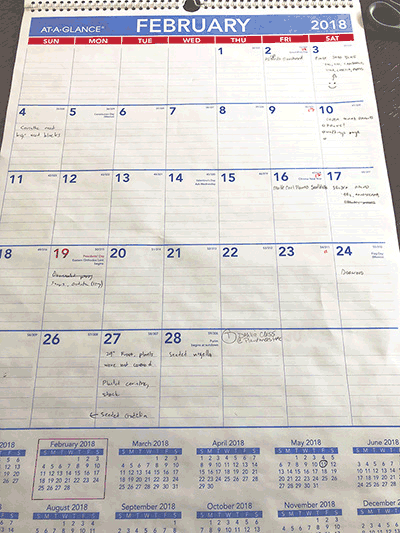
David and Lina Brunton, owners of Right Field Farm in Maryland, rely on a number of reminders to know what to plant when, but their wall calendar is ever-present as a daily reminder.
"The easy one that we use all the time is a big wall calendar, something that we adapted directly from Lisa Mason Ziegler of The Gardener's Workshop," David explains. "The wall calendar chronicles the life of a plant from seed to harvest, and it works better for us than any kind of database or spreadsheet — although we use those, too."
When sowing seeds, they write down the tray number, the variety, the bump-up date (if required), plus dates when a start hardens off and when it's planted. In a perfect world, David and Lina also jot down the first harvest date.
"Another number we're going to try recording this year is the count for every stem we cut. I think that will help when we're deciding what to plant next year," he adds.
After trying out a variety of different labeling materials, the Bruntons now rave about the efficiency they've gained by using little brass tokens with numbers stamped on them. Outdoors, each row is also numbered, making quick-referencing a cinch. "Having some agreed-upon way to indicate where you're supposed to plant or prep or harvest or weed is nice," David admits.
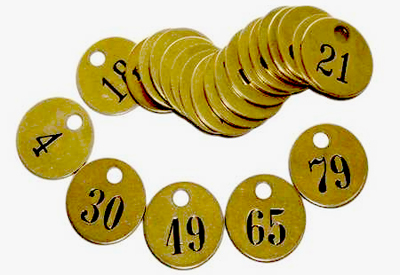
6 Planting Seasons at Right Field
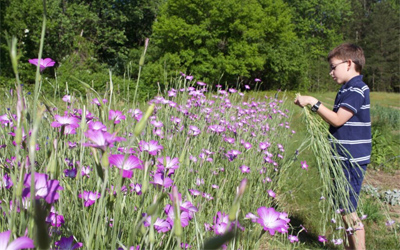
Right Field Farm phases its plantings over 6 "seasons" throughout the year:
- The first phase begins with sowing long-season annuals over the Martin Luther King, Jr. holiday weekend in January. This usually amounts to "a few trays of seeds under lights in the basement," David points out.
- The second phase, which David describes as spring annuals, includes many of the same flowers overwintered from the prior fall planting: Agrostemma, bachelor's buttons, snapdragons, stock, Rudbeckia, Scabiosa, bells of Ireland, and Cerinthe. Because these are generally frost-hardy varieties, the spring annuals are often transplanted first.
- That makes room in the sowing area for the first succession of summer annuals, including "workhorses" like zinnias, Cosmos, Celosia, and sunflowers. These are all planted in 4 successions, but only the sunflowers are direct-sown outdoors: "We've adapted the first of Johnny's Sunflower Succession-Planting Programs. We direct-seed 3 varieties in the same plot at the same time, all with different blooming times. It's worked great for us, and we pack them in close and don't over-feed because we like smaller sunflowers for our arrangements," he says.
- Next, the fourth phase: a mid-summer sowing of perennials and biennials, including Echinops, Eryngium, lupine, columbine, and Echinacea, for blooms in the following spring through summer. "That timing gives the plants enough time to get established in the ground."
- David and Lina take a planting break in August, followed by a September planting of cool flowers and spring bulbs. "Our farm adds more perennials every year. Each fills its own seasonal slot, from early hellebores, branches, and spring bulbs, to peonies, then summer bulbs and corms like tuberose, gladiolas, and dahlias."
- The sixth and final phase of succession planting that can't go unnoted involves cover crops. Right Field plants rye for cover during winter to prevent erosion and add organic matter; a mix of varieties including cowpeas during the spring; and buckwheat in the summer.
BRIGHTFLOWER FARM • Illinois
Growing Zone: 5a • Ecoregion: Rock River Hills
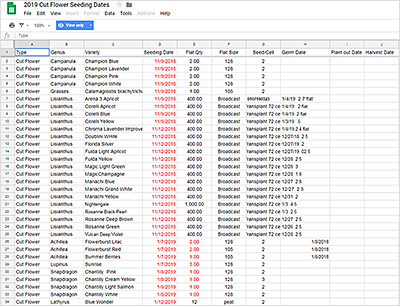
At Brightflower Farm, Jeanie McKewan use Google Drive to access files from both her desktop and her smart phone, making it easy for crew members to reference even while outdoors.
Based in the Illinois Driftless Area, just 10 minutes from the Wisconsin border, Brightflower Farm is in its 13th season of growing a diversified mix of cut flowers and plants for customers that include several Chicago-area Whole Foods outlets and wedding and event florists in Chicago and Madison markets.
Jeanie credits now-retired flower farmer Joe Schmidt, cofounder of Fair Field Flowers in Madison, Wisconsin, for many of her successful techniques. "It all starts with a seeding log of all the flowers I will grow," she says. "For each variety, we have: 1) a sowing date; 2) the number and 3) size of flats; and 4) the number of seeds per cell. We then record 5) the germination date; 6) planting date; and — if I can stay up to date with my record-keeping, I'll note 7) how much we harvested."
Jeanie creates a spreadsheet from her master plan, and brings it out to the sowing bench to document each day's activities. "I bring that back to my computer and update the log," Jeanie says. She turns the seeding dates from black to red type, an at-a-glance trick for knowing what's already been sown.
Paired with the Google documents is a master map of all the fields and rows within each section. "We mark what is planted in each row and the date planted."
Most of the farm's flowers are sown in seedling flats, then transplanted to the field, rather than being direct-sown. "I believe you have better luck with sowing in flats followed by transplanting, because you're putting a stronger, larger plant into the soil — plus, they have a jumpstart on outpacing weeds."
Planting Frequency
RED TWIG FARMS • Ohio
Growing Zone: 6a • Ecoregion: Loamy High Lime Till Plains
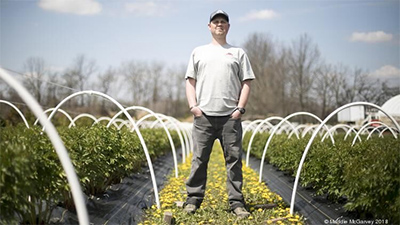
“My goal is to achieve about a 2-week window between sowings,” says Josh, who also gauges his sowing schedule by germination rates listed on the seed packets.
Josh and Lindsey McCullough own Red Twig Farms, located in a suburb of Columbus, Ohio. The couple began their 5½-acre farm as a division of McCullough's Landscape & Nursery, Josh's parents' business. They have since spun off as an independent cut-flower farm specializing in woody branches (twig dogwood and willow) and peonies. With the addition of a 20x36ft2 high tunnel and several caterpillar tunnels, Red Twig recently added spring bulbs (ranunculus and anemones) and seeded annuals to their production plan.
"We want to adapt to the markets and be more than a two-season business," he explains. Red Twig Farms ships 90% of their branches to out-of-state customers, while wholesale cut peonies and annual flowers go to local florists and DIY brides. At their seasonal Farm Store on the McCullough's Landscape & Nursery grounds, they sell flowers to the community.
Josh primarily starts his own seedlings, beginning sowing in early February. "Last year, we planted snapdragons, Celosia, Eucalyptus ('Baby Blue' and 'Silver Drop'), Delphinium, and Dianthus. "I look at the germination information for the individual packets and schedule (sowing) on our calendar," he explains. "My goal is to achieve about a 2-week window between sowings."
Since Red Twig Farms is relatively new to growing flowers from seeds, Josh says they've started with a few popular varieties, including the 'Madame Butterfly' snapdragons, 'Queeny Lime Orange' zinnias, and a number of sunflower varieties.
BRIGHTFLOWER FARM • Illinois
Growing Zone: 5a • Ecoregion: Rock River Hills
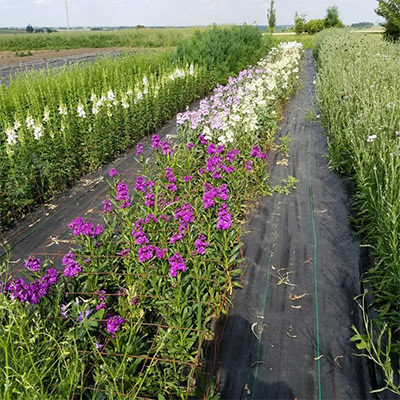
While for many, succession planting is a weekly or biweekly ritual (think sunflowers and zinnias), Jeanie at Brightflower extends her stock (Matthiola) availability by planting "spring" and "fall" successions. With a lovely, clove-like scent and pretty color palette, this cold-hardy crop with a rapid growth cycle lends itself nicely to shoulder-season production.
"Our spring planting is on the first of February, while our fall planting is on the first of July." The second planting continued to generate farm income into the holiday season. "Last year, I cut stock in the final week of November, which allowed us to deliver Mason jar arrangements with fresh stock, mums, greenery, and winterberry to grocery customers in early December," Jeanie says.
FLORA FARM • Oregon
Growing Zone: 8b • Ecoregion: Oak Savanna Foothills
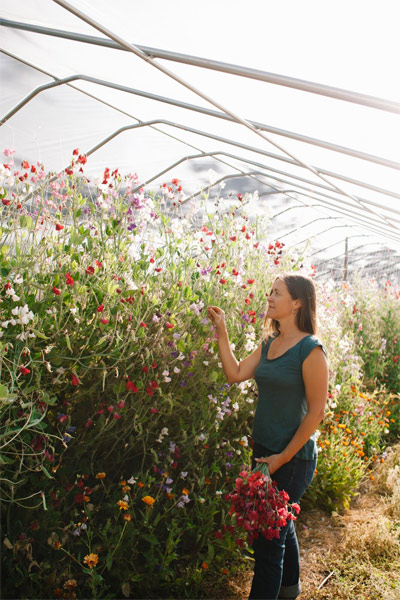
In contrast, Jeanie at Brightflower Farm (Zone 5a) can expect to begin harvesting her sweet peas around the end of May, according to her records.
Depending on how much acreage is available, you may need to address issues around the frequency of sowing, such as these, raised by Stacey of Flora Farm:
- Am I tending my soil fertility by rotating plant families and adding compost/amendments between crops?
"Short crop rotations demand a lot from the farm organism," she notes. - What's my method of turnover, from one crop to another — e.g., mowing and tilling or hand-pulling, followed by tilthing/forking and planting?
"I need to plan to have the resources (machines, farm hands, time for decomposition), available at this extremely busy time of year (May and June)," she says. - How long is my harvest window for my cool-season annuals? Can the later heat-lovers I'm planting afterwards take light frost?
"In my climate, heat-lovers that are planted out past the first week of July have trouble maturing a sufficient quantity of flowers to make the effort of planting and maintaining the crop worthwhile," Stacey explains. "Things that can take light frost, however, such as Cosmos and Tulsi basil, are good choices for following the cool-season annuals that are later to finish out." - Can I have even more success with succession planting by using low tunnels in the field?
"I have found my successions are approximately 2 to 4 weeks earlier when grown under low tunnel cover."
Record-Keeping
The best reason to keep accurate records is to forecast what particular variety, and when, you'll harvest in the future, Jeanie of Brightflower says.
"Noting the dates when I start harvesting gives me important data to quote, especially with designers and their brides. Each year, for instance, florists will ask, 'Are you going to have sweet peas at the end of May?' And I can look up to see that I started cutting my white sweet peas on May 31st last year. Or, that I started cutting 'Coral Charm' peonies on May 22nd, so I can say, 'I should have them for your May 25th wedding this year.' "
Noting the quantity harvested each year allows you to compare against the quantity planted. The percentage germination rates fluctuate by variety, so these comparisons help Jeanie know when to increase the percentage of seeds she sows accordingly.
At Red Twig Farm, the McCulloughs label the crop and variety when sown, making note of the best start date. "Record-keeping is important to us," Josh says. "We're noting different soil and ambient temperatures. We even track how we amend the soil."
The Flower Peddler • New Jersey
Growing Zone: 7a • Ecoregion: Inner Coastal Plain

“… My phone is kept with me at all times. As I'm going through the season, I take notes. And then my phone will alert me when it's time to do it again.”
Bethany Bernard and her husband Dan Vohringer of New Jersey-based The Flower Peddler grow cut flowers on 10 acres, serving wedding and event florists, DIY wedding clients, and customers at four farmers' markets.
Bethany relies on her smart phone as the best planning and recordkeeping tool. "I don't live off of coffee and spreadsheets," she jokes. "I have a calendar that I write in, but it's on my phone. My phone is kept with me at all times. As I'm going through the season, I take notes. And then my phone will alert me when it's time to do it again."
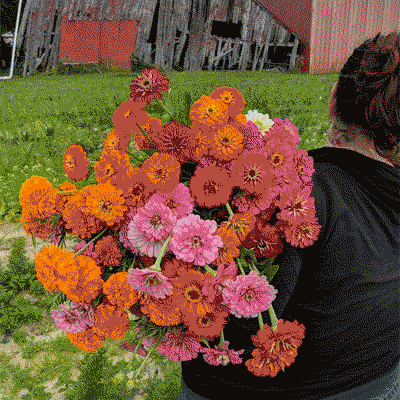
Because of limited greenhouse space to start seedlings, Bethany uses 3 planting methods: 1) direct-sowing; 2) planting pre-ordered plugs; and 3) seeding in trays for transplants.
"We direct-sow sunflowers, Cosmos, zinnias, annual grasses, and grains. We do some seeding for transplants in our basement — sweet peas and asters, for example." She refers to the previous years' notes and photos, all of which are stored on her phone, to plan and order when plugs should be delivered. "I do that for the entire season, and tell my broker which plugs I want delivered at that same time next year."
A Note about Experimentation
Last season, the Bruntons of Right Field Farm (Growing Zones 7a/7b) thought they'd try planting biennials a little bit earlier than usual. The result was that "around the middle of October, we had a bunch of Dianthus begin to bloom — which wasn't what we intended. So, we went back to the calendar to see when we had sown dianthus in our seed blocks," David explains. "Lo and behold," the record showed "it was in mid-June, which turned out to be too early if we wanted those dianthus to overwinter, but not quite early enough if we wanted a big fall crop. All that was evident from the calendar."
Whether it's to chronicle what did or what did not work out, the notes you take today can put you on the track to a favorable result next time.
Favorite Flowers for Succession Planting
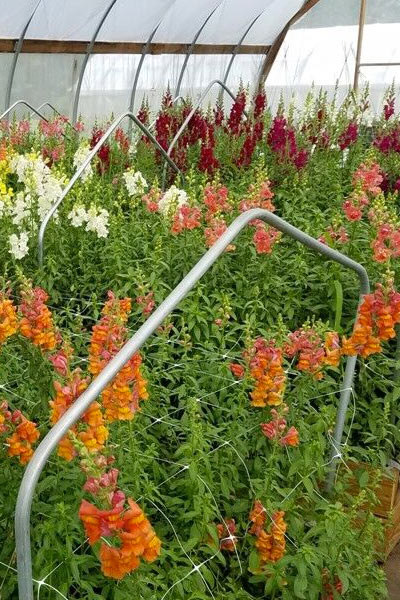
Brightflower Farm • Growing Zone 5a
Any flower that is "day neutral" is a good candidate for multiple plantings, Jeanie says. "I can do five to seven snapdragon sowings over the season. We track it by date; for example, we start snaps in January and our last sowing is at the end of May or early June."
Right Field Farm • Growing Zones 7a/7b
David and Lina prefer to grow long-season annuals from seed. Recurring hits include Eucalyptus, lisianthus, Campanula, and David's personal favorite, Icelandic poppies.
Flora Farm • Growing Zone 8b
Keep in mind that mowing and cutting perennials back hard can also provide you with a tool to manage bloom succession. Some of Stacey's favorite perennials include the following.
- Scabiosa atropurpurea and Rudbeckia hirta. FYF (first-year flowering), beginning in mid-July. Mowing after seed pods begin formation leads to another harvest window in September. Subsequent years' flowering begins a few weeks earlier (late June), but second fall harvest after mowing/pruning is comparable.
- Achillea millefolium and Veronica. FYF. Cut back hard after first bloom in May for a second flush in late summer.
- Heliopsis. An FYF perennial that blooms in June and will produce a second flush of blooms in late summer, if cut back hard after first flush.
- Monarda 'Bergamo'. Although an annual, Monarda 'Bergamo' will begin flowering in early July from a February seeding and will produce a second flush of blooms in September, if cut back hard after first flush.
Get Started & Keep Learning by Doing
Chronicling your floral activities may feel like too much admin-type work, when you'd rather have your hands in the soil. But devising a system of planning and recordkeeping is one skillset that sets a successful course for any flower farm, regardless of size.
The best advice I've learned from these conversations is to JUST START. Whether you use a mobile or desktop device, a conventional spreadsheet, an app, index cards, or an old-fashioned paper calendar, it's not so much the method that matters as the discipline.
You'll find what works best for you, and thank yourself next season and in many seasons to come!


